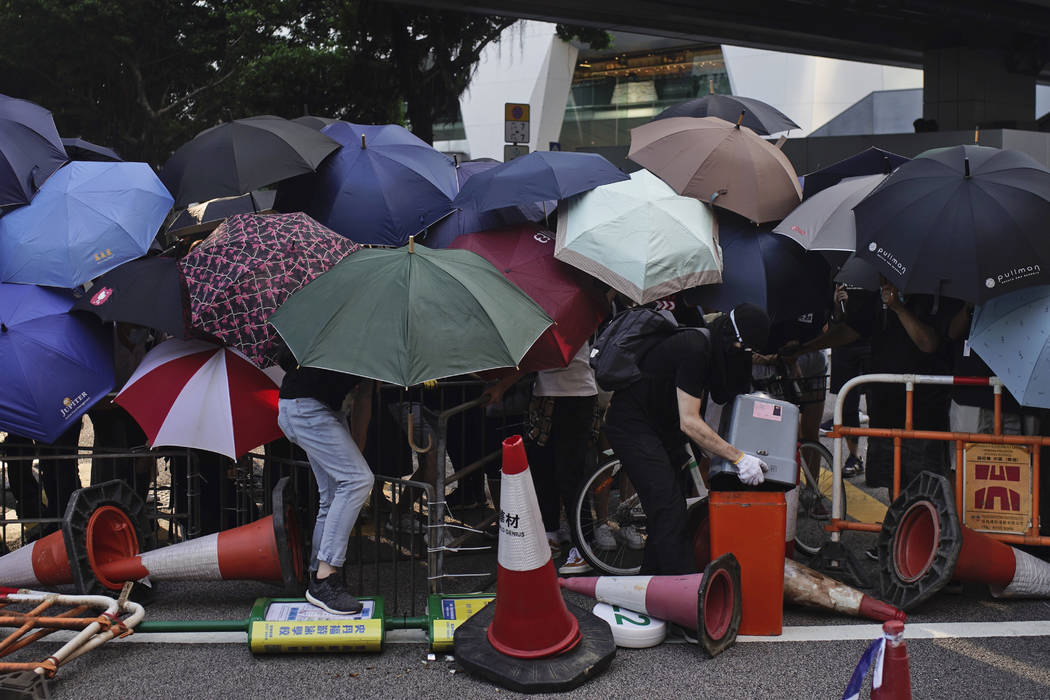Hong Kong violence erupts as thousands protest mask ban

HONG KONG — Violence erupted across Hong Kong as defiant masked protesters rampaged and police fired tear gas Friday, hours after the city’s embattled leader invoked rarely used emergency powers to ban masks at rallies in a hardening of her stance after four months of anti-government demonstrations.
Challenging the ban, set to take effect Saturday, thousands of protesters crammed streets in the central business district and other areas, shouting “Hong Kong people, resist.” Pockets of angry protesters later attacked Chinese bank outlets, vandalized subway stations and set street fires, prompting police to respond with tear gas in many areas.
Hong Kong Chief Executive Carrie Lam told a news conference that the mask ban, imposed under a colonial-era Emergency Ordinance that was last used over half a century ago, would be “an effective deterrent to radical behavior.”
The ban applies to all public gatherings, both unauthorized and those approved by police.
Lam stressed it doesn’t mean the semi-autonomous Chinese territory is in a state of emergency. She said she would seek the legislature’s backing later for the rule.
“We must save Hong Kong, the present Hong Kong and the future Hong Kong,” she said. “We must stop the violence… we can’t just leave the situation to get worse and worse.”
Legal challenges filed
Two activists immediately filed legal challenges on grounds the mask ban will instill fear and curtail freedom of speech and assembly. The High Court was hearing a bid late Friday to halt the ban.
The ban makes the wearing of any face coverings, including face paint, at public gatherings punishable by one year in jail. A six-month jail term could be imposed on people who refuse a police officer’s order to remove a face covering for identification.
Masks will be permitted for “legitimate need,” when wearers can prove they need them for work, health or religious reasons.
“Will they arrest 100,000 people on the street? The government is trying to intimidate us but at this moment, I don’t think the people will be scared,” said a protester who gave his surname as Lui.
Tougher measures possible
Lam wouldn’t rule out a further toughening of measures if violence continues. She said she would not resign because it wouldn’t help since Hong Kong is in “a very critical state of public danger.”
Thousands of masked protesters marched before Lam spoke. The rallies spread to many areas at night as protesters vowed they wouldn’t be cowed. Some blocked traffic with road barriers, smashed up shops, vandalized subway stations and set fires including burning a Chinese flag in familiar scenes of chaos. Some malls and all subway stations were shut.
“The Hong Kong police are also wearing their masks when they’re doing their job. And they don’t show their pass and their number,” said protester Ernest Ho. “So I will still keep my mask on everywhere.”
Face masks have become a hallmark of protesters in Hong Kong, even at peaceful marches, amid fears of retribution at work or of being denied access to schooling, public housing and other government-funded services. Some young protesters also wear full gas masks and goggles to protect against tear gas.
Identity concerns widespread
Many also are concerned their identities could be shared with the massive state-security apparatus that helps keep the Communist Party in power in mainland China, where high-tech surveillance including facial recognition technology is ubiquitous.
Analysts said the use of the Emergency Ordinance set a dangerous precedent. The law, a relic of British rule enacted in 1922 to quell a seamen’s strike and last used to crush riots in 1967, gives broad powers to the city’s chief executive to implement regulations in an emergency.
“It is a dangerous first step. If the anti-mask legislation proves to be ineffective, it could lead the way to more draconian measures such as a curfew and other infringement of civil liberties,” said Willy Lam, adjunct professor at the Chinese University.
Carrie Lam bristled at a suggestion that the ban nudges Hong Kong closer to authoritarian rule. She insisted she was not acting under orders from Beijing, which she visited this week when Communist Party leaders celebrated 70 years in power on Tuesday.
The ban followed widespread violence in the city on Tuesday that marred China’s National Day and included a police officer shooting a protester, the first victim of gunfire since the protests started in June over a now-shelved extradition bill. The wounded teenager was charged with attacking police and rioting.
Becomes anti-China movement
The movement has snowballed into an anti-China campaign amid anger over what many view as Beijing’s interference in Hong Kong’s autonomy. More than 2,100 people have been detained so far, including 204 charged with rioting, which carries a penalty of up to a decade in prison.
British Foreign Secretary Dominic Raab said Lam’s government should avoid aggravating tensions and that “political dialogue is the only way” to resolve the conflict. Malaysian Prime Minister Mahathir Mohamad, the world’s oldest leader, said Lam should resign and predicted Beijing will send in its military to end the crisis.
The government last month withdrew the extradition bill, which would have allowed suspects to be sent to mainland China for trial, but protesters have widened their demands to include direct elections of the city’s leaders, an independent inquiry into alleged police brutality, the unconditional release of protesters and not characterizing the protests as riots.
“Five demands, not one less!” many protesters shouted during Friday’s rallies as they held up five fingers.